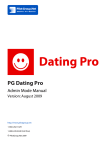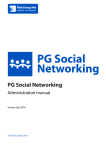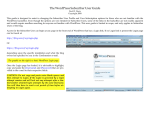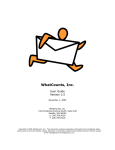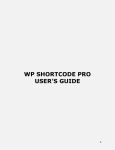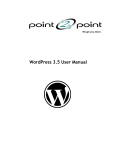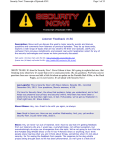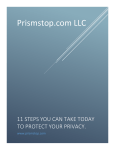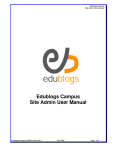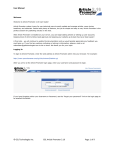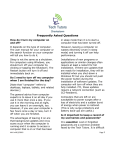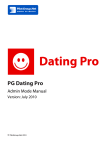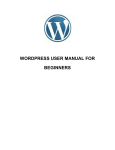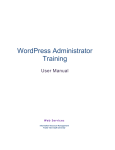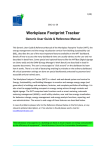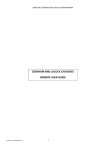Download What are Pages and Posts?
Transcript
Table of Contents Introduction .................................................................................................................................................. 1 What is WordPress? .................................................................................................................................. 2 Log in to the Administration Dashboard ................................................................................................... 3 The WordPress Dashboard ....................................................................................................................... 4 Managing Content ........................................................................................................................................ 5 What Are Pages and Posts??..................................................................................................................... 6 Managing Posts How to Add a New News Post ......................................................................................................... 7 Add One Image or File to Your Pages or Posts............................................................................... 10 Adding Multiple Images to a Post .................................................................................................. 13 Managing Pages How to Manage Existing Pages ...................................................................................................... 15 How to Create New Pages ............................................................................................................. 17 How To Add Pages to the Menu .................................................................................................... 19 How to Style Text in Pages and Posts ............................................................................................ 20 How to Manage the Media Library What is your Media Library? .......................................................................................................... 21 Viewing and Editing files in the Media Library .............................................................................. 22 Uploading Files through the Add New Media Screen .................................................................... 24 Managing Functionality ............................................................................................................................. 25 Plugins What is a Plugin?............................................................................................................................ 26 Installing a Plugin .......................................................................................................................... 27 Deactivating a Plugin ..................................................................................................................... 32 Updating a Plugin .......................................................................................................................... 33 Widgets What is a Widget? .......................................................................................................................... 34 Adding a New Widget ................................................................................................................... 35 Editing a Widget ............................................................................................................................ 37 Users User overview ................................................................................................................................ 38 Adding new Users ......................................................................................................................... 39 Editing User Profiles ...................................................................................................................... 41 Kitchen Sink ................................................................................................................................................ 42 Security ................................................................................................................................................... 43 Change your Administration Password................................................................................................... 44 Themes and Additional Features ............................................................................................................ 45 WordPress is a popular free and open source Content Management System (CMS), which allows you to independently maintain the content of your Web site, keeping it up-todate and supporting your business and its operations. 1 | point2point WordPress 4.0 User Manual What is WordPress? WordPress is a popular Content Management Systems(CMS) that allows web site administrator, from social media managers to the top level executive, to easily add and edit text, images and video on their Web site. WordPress falls into the classification of a blogging platform but is now used as a base for building a entire web site. A user name and password is required to login to the WordPress Dashboard, the top level administrator has the ability to make other users who wish to update content at various permission levels. The blog aspect is usually saved for a news or press releases page, just a chronological list of news posts. WordPress also allows for the creation of additional pages of your web site with no HTML knowledge necessary. This is great if you are adding a new service or area of expertise which you would like to have on the main top navigation and not buried within your site. You also have the ability to add sub pages or child pages to any top or parent page which allows you to divide your services or products into their own separate pages. With WordPress you can easily upload images through your browser and resize them, create thumbnails or entire galleries without any image editing software. All through your web browser which means you can access it literally anywhere you have an Internet connection. There are hundreds of not thousands of CMS’s currently available online, some community supported, some developed by a company and sold. I’ve tried quite a few of them and a few years ago decided to develop our sites on the WordPress content management system. It’s community supported and offered free to the public and even comes with hundreds of free themes or templates. Where point2point comes in is we install it, configure it to maximum security, and then design a custom theme to accurately portray your company or organization’s image to the world. Most aspects of a Web site can be edited through WordPress except for certain design aspects of the site which would require a Web developer to modify and then upload. Certain things like company logos in the header and other “design aspects” of the site are usually un-editable. Since WordPress is so dynamic, there is endless customization to make pretty much everything possible to manage but usually not cost effective or necessary. 2 | point2point WordPress 4.0 User Manual The Two Type Of WordPress WordPress.org WordPress.org is a downloadable application which you would upload and install on a Web server that supports PHP and MySQL. This is the most commonly used for businesses and organizations that have their own domain name(YourName.com). The main and most important feature is the ability to install custom WordPress themes and Plugins. Popular Plugins allow for online forms, social media links to allow users to quickly post your blog post to Facebook, Twitter and other social media sites and pretty much anything you can think of that you would like your WordPress site to have. A simple Google search will usually provide instant results for the Plugin you are looking for. WordPress.com WordPress.com, on the other hand, does not require a sub domain or a hosting package but lacks several key features that the WordPress.org install allows. WordPress.com blogs also use WordPress.com domain. For example, a WordPress.com web site or blog would have the address of http://blogname.WordPress.com WordPress.com blogs are great for personal blogging and not recommended for businesses or organizations that would be better represented with a domain name(YourName.com). 3 | point2point WordPress 4.0 User Manual Log In to the Administration Dashboard To update pages, you must first log in to the Administration Dashboard in WordPress. The login area is shown below. 1. To log in to the Dashboard, first browse to the address below: http://www.YourSiteName.com/wp-admin/ Important: Replace YourSiteName.com with your Web site’s address then add /wp-admin/ to it. 2. When the WordPress login page displays, enter your username and password in the fields provided. If you point2point is hosting your site, your Dashboard address, user name and password are located in your Welcome e-mail you received upon payment. 4 | point2point WordPress 4.0 User Manual The WordPress Dashboard The WordPress Dashboard will then load upon successfully login. From the Dashboard you will have access to all of the content and functionality of your Web site. This page gives you a summary of how many pages you have created, how many posts have been created and also gives you the ability to create a Quick Post which will immediately be displayed on your News page upon publishing. Most importantly this is where will you edit and create new Pages and Posts. 5 | point2point WordPress 4.0 User Manual The benefit of a WordPress CMS is that changes to content can be applied directly to the Web site by the customer without external Web programmer services—making updates and maintenance easy. 6 | point2point WordPress 4.0 User Manual What are Pages and Posts? Posts Posts are the entries that display in reverse chronological order on your news page (if you have one). In contrast to pages, posts usually have comments fields beneath them and are included in your site's RSS feed. Posts are usually populated with one or two test posts that usually referring to the launch of the Web site, event details and other press releases or news articles. Posts can be organized by Categories and Tags. Categories are used for a broad grouping of post topics. Before we had tags, if you wanted to describe a post in more specific terms then more categories were required. That led to very long category lists inside the blog and very long lists in Categories Widgets. Tags are the digital equivalent of real tags — little labels you attach to things. Tags have an advantage over categories in that they aren’t pre-set. When you attach tags you write them in manually and have the freedom to write whatever you want. If a tag doesn’t exist already, it will once you’ve hit publish. Pages Pages are the different sections of your Web site and are typically static in nature. A good example of a page is the information contained in About or Contact pages. A page should not be confused with the time-oriented objects like Posts, nor should a WordPress page be confused with the word "page" referring to any Web page or HTML document on the Web. Pages are sometimes filled with Latin text called Lorem Ipsum, which is a gibberish placeholder for your content. When you want to add content to a page, just click on All Pages, click on the page you’d like to edit, delete the Lorem Ipsum and replace it with your own text. 7 | point2point WordPress 4.0 User Manual How To Add A New News Post To add a new post to your News page: 1. Click the Posts > Add New link on the left side of the screen: 2. The Add New Post page will then load. 8 | point2point WordPress 4.0 User Manual 3. Select a category for your post under the categories tab on the right. The category will determine where the post is displayed on your site. For example, Posts assigned to the "News" category will be posted on the News page of the site. 4. In the Title area, type in the title of your new post (New Staff Changes, Happy Mardi Gras, Hurricane Announcement.)In the Body area (below the editing toolbars), enter text for the post and/or add images (see Add Images to Your Page/Post for instructions). 9 | point2point WordPress 4.0 User Manual When you have finished adding content to your new post, you can: Click the Save Draft ( ) button and save this post as a draft. The post will not be published to your site. You can come back later and make further changes, publish the post, or delete the draft. Click the Preview ( ) button. The post will display in a new window for your review. This is how your post will look when it is published. When you are finished reviewing the post, close the preview window. You will be returned to the Add Post screen. Click the Publish ( ) button. The new post will be published to the news portion of your site. To view the new post, click the View Post ( ) link at the top of the screen to view the page live. (The Add New Post screen will switch to the Edit Post screen once your post has been published.) 5. The post is then published to your news page 10 | point2point WordPress 4.0 User Manual Add An Image Or File to Your Pages Or Posts WordPress allows you to easily add images and any other type of file (PDF, Excel Document, Word Document, etc) to your Pages and Posts. 1. The first step is to click on the Add Media button. 2. This will bring up the Insert Media window where you can either drag and drop the files or images you’d like to insert into the Page or Post, or browse for them on your computer. 11 | point2point WordPress 4.0 User Manual 3. Click the Select Files button. Locate the image on your computer that you want to add in the File Select window, click on it and then click Open. 4. After your image has been uploaded successfully, a thumbnail version of the image will display: This page will allow you to add a caption, description and also allow you to specify what happens when you click on the image (Link URL). You have 4 customization options when you click on the image: Title, Caption, Alt Text1 and Description of the image Alignment of the image. You may align the image in the center of the page, or the right or left of a block of text. Link to an attachment page, media file or nothing (nothing suggested). Size is display size of the image once it’s inserted 1 Alt text is a very short description that conveys the same essential information as the image should that image be unavailable to the reader (as in the case of readers with a visual impairment). 12 | point2point WordPress 4.0 User Manual 5. You are now ready to insert the image into the post, click Insert into post ( ) on the bottom right 6. The image is now inserted into the Post or Page. Upon clicking on the image you are able to make additional changes by clicking on the pencil icon or you may delete the image by clicking on the x. 13 | point2point WordPress 4.0 User Manual Adding Multiple Images To Page Or Post WordPress can create an image gallery with similar steps. 1. Click on the Add Media button 2. Select the images you’d like to add to the gallery by clicking on them 3. Click Create a new gallery ( 14 | point2point WordPress 4.0 User Manual ) 4. You will then have the option to edit your gallery. Click on any of the images to add titles, captions, alt text or descriptions, or drag and drop images to reorder them. 5. Click on ( ) 6. The gallery will then be inserted to your Page or Post 15 | point2point WordPress 4.0 User Manual How To Manage Existing Pages To edit existing pages: 1. Click the Pages > All Pages link on the left side of the screen: All pages contained within your site will be listed. 2. In the list, find the page you want to manage and then click the Edit link underneath it. The selected page will display in edit mode. 16 | point2point WordPress 4.0 User Manual 3. Make any changes or updates needed. See the Add Images to Your Page section of this document for instructions on adding images. 4. Once you have finished making changes, you can click the Preview ( ) button to open the page in a new window for review before publishing. Or, you can click the Update ( ) button to publish your changes without previewing the changes. Please note that you will have a Publish ( ) button if the page has never been published. 17 | point2point WordPress 4.0 User Manual How To Create New Pages *Note: If point2point built your site, usually we will create all of the pages you need based on Needs Analysis meetings, so it is rare that you will need to create a new page. If a new page is needed, follow the steps below. 1. After you have logged in to the Administration Dashboard, click Pages > Add new. The Add New Page will then load. 18 | point2point WordPress 4.0 User Manual 2. In the Title area, type in the title of your new page (About, History, Contact, etc.) 3. In the Body area (below the editing toolbars), enter text for the page and/or add images (see Add Images to Your Page for instructions). 4. When you have finished adding content to your new page, you can: Click the Save Draft ( ) button and save this page as a draft. The page will not be published to your site. You can come back later and make further changes, publish the page, or delete the draft. Click the Preview ( ) button. The page will display in a new window for your review. This is how your page will look when it is published. When you are finished reviewing the page, close the preview window. You will be returned to the Add New Page screen. Click the Publish ( ) button. The new page will be published to your site. To view the new page, click the View Page ( ) link at the top of the screen to view the page live (The Add New Page screen will switch to the Edit Page screen once your page has been published). You will then have the ability to view the page now that it has been published by simply clicking View Page. Also displayed is the Permalink, the permanent address of the Page published. 19 | point2point WordPress 4.0 User Manual Adding a Page To The Menu 1. Now that the page has been created, you’ll need to add it to your Web site’s menu. To accomplish this, on the left hand side of the Dashboard click on Appearances > Menus. 2. Upon loading the menus page, you’ll have several options on how to add the new page. Some Web sites have multiple menus but most only have one which will be auto selected. You can also link to an outside URL under Custom Links by entering the Website’s address in URL and the Label that you’d like to show under the menu. To add the page we just created, simply check the box next to the page you’d like under Pages and then click Add To Menu. This will then add the page to the menu to the right. You can drag the menu item above and below the other menu items to it’s appropriate spot. 3. Click Save Menu ( ) and the new page will be added to the Web site. 20 | point2point WordPress 4.0 User Manual How To Style Text in Pages and Posts To add styles to the text in your pages and posts, use the style bar shown below. Click to Expand the toolbar The buttons in the style bar and their functions are listed below. - Bold text - Underline - Italic text - Justify - Strikethrough - Text Color - Bullet points - Paste text as plain text (w/o formatting) - Numbered List - Clear formatting - Block Quote - Insert Special Character - Insert Horizontal Line - Align Left/Center/Right - Increase/Decrease Indent - Undo/Redo - Insert/Edit a Link - Full Screen Editor - Remove a Link - "Kitchen Sink" - Expand Toolbar - Change text style (body, heading, etc.) 21 | point2point WordPress 4.0 User Manual What is Your Media Library? Your Media Library contains any images, video, and files that you upload and use on your Web site. Usually, media is uploaded and inserted when creating a post or a page (as shown in the sections of this manual describing how to add images to a page/post). From within the Media Library screen, you may view, edit, and delete previously uploaded media. You may also add images, videos, .pdf files, etc. through the "Add New Media" screen within the Media Library. 21 | point2point WordPress 4.0 User Manual Viewing and editing files in the Media Library 1. From the Dashboard, click on Media > Library 2. The library will look like this: 22 | point2point WordPress 4.0 User Manual 3. To view the details of any image, such as the URL or Title, simply click on it 4. After you click on an image, you have the option to change the title, caption, Alt Text, or Description 23 | point2point WordPress 4.0 User Manual Uploading files from "Add New Media" screen 1. From the Dashboard, Click on Media > Add New 2. Click the Select Files button. Locate the image on your computer that you want to add in the File Select window, click on it and then click Open. Or you may simply drag and drop images from finder/explorer. 24 | point2point WordPress 4.0 User Manual Using WordPress plugins and widgets, you can make your Website function however you need it to. From setting up an ecommerce store, to managing events, to displaying your portfolio, the WordPress CMS makes it easy to fully customize your site's functionality. 25 | point2point WordPress 4.0 User Manual What is a Plugin? Plugins allow you to customize, and add to, the functionality of your site, so that you may modify it to your needs. They either augment features that already existed on your site, or offer new features. Contact forms, image galleries and sliders, e-commerce, security, SEO solutions, and event calendars are just a few of the many functions offered by common Plugins. Many Plugins are available at no cost, while Premium Plugins are available for either a one time or monthly fee. For an extensive list of available Plugins , you may visit the Plugin directory at https://WordPress.org/Plugins. 26 | point2point WordPress 4.0 User Manual Installing a Plugin There are two ways to install a plug-in, you can search for Plugins from your WordPress Dashboard, or you may upload plug-ins that you have found and downloaded from searching in your browser. To search for and install a Plugin from the WordPress Dashboard 1. From the Dashboard, click on Plugins > Add new 2. You may browse for Plugins by "featured", "popular", "favorites", or by a descriptive tag 27 | point2point WordPress 4.0 User Manual You may also search for a specific plug in 3. Once you have found a Plugin you would like to install, click on "Install Now" ( ) 4. A window will pop up asking you to confirm that you would like to install, click OK 28 | point2point WordPress 4.0 User Manual 5. The Plugin will then install automatically. When it has finished installing, click on "Activate Plugin" Important Note: Do not navigate away from this page while you are installing a Plugin. Doing so will suspend your site in maintenance mode, causing it to display an error message. Wait for the installation to complete before you click away from the page. 6. That's it! Your Plugin has been installed and activated and is ready to use 29 | point2point WordPress 4.0 User Manual How to add a Plugin that you have downloaded: 1. From the Dashboard, click on Plugins > Add New 2. Click on the "Upload Plugin" link 2. Click on "Choose File" 3. Select the Plugin .zip that you downloaded and click open 30 | point2point WordPress 4.0 User Manual 4. Click "Install Now" ( ) 5. The Plugin will install automatically, click on "Activate Plugin" link to complete the process Important Note: Do not navigate away from this page while you are installing a Plugin. Doing so will suspend your site in maintenance mode, causing it to display an error message. Wait for the installation to complete before you click away from the page. 31 | point2point WordPress 4.0 User Manual How to deactivate a Plugin: 1. From the Dashboard, click on Plugins > Installed Plugins 2. Find the Plugin you would like to deactivate 3. Click on the "Deactivate" link under the Plugin 32 | point2point WordPress 4.0 User Manual Updating Plug-Ins For security reasons, it is important to keep your Plugins updated to the newest version. This section outlines how to update WordPress Plugins. 1. From the Dashboard, click on Dashboard > updates. If any your installed Plugins need to be updated, they will show up here. of 2. Check the box next to the Plugins you want to update (or check the box next to "Select All" if you wish to update everything) 3. Click "Update Plugins" 4. Allow the update(s) to complete before navigating away from the page. Your Plugins are now updated. Important Note: Do not navigate away from this page while you are updating a Plugin. Doing so will suspend your site in maintenance mode, causing it to display an error message. Wait for the update to complete before you click away from the page. 33 | point2point WordPress 4.0 User Manual What is a Widget? WordPress widgets are used to add content to your website's sidebars and footer, and can be customized to display almost any information. Some examples of common widgets are Navigation menus Recent post listings Contact information Search bars Tag clouds The above examples are some of the default widgets that come with WordPress, but you will often find individual Plugins and Themes will add their own widgets as well. In their basic form, widgets do not require any coding experience, and they can be added, removed, or re-ordered within the WordPress Dashboard. This section will cover the basics of adding and editing WordPress widgets. 34 | point2point WordPress 4.0 User Manual To add a new widget to your sidebar or footer 1. Click on Appearance > Widgets link on the left side of the screen 2. The Widgets page will then load. 35 | point2point WordPress 4.0 User Manual Available widgets are listed on the left: Widget locations are listed on the right: 3. To add a widget to the sidebar or footer, click on it > click on the desired location > click add widget. You can also move widgets by dragging and dropping them into the widget locations. Once a widget has been added to a sidebar or the footer, it can be edited. 36 | point2point WordPress 4.0 User Manual To Edit a Widget 1. Click on the grey arrow on the left side of the widget 2. Fill in the title and any other relevant parameters 3. Click save ( ) 4. The widget will now be displayed in the sidebar 37 | point2point WordPress 4.0 User Manual Why do WordPress Users Matter? There are a few reasons why you may find yourself having to manage users for your site. For example, you may want to teach employees/co-workers how to update the website or create posts. Or perhaps you have a member based site that requires people to subscribe and log-in to view content. This section explains how to manage and add new users in WordPress. 38 | point2point WordPress 4.0 User Manual To add a new user 1. Click on Users > Add New 2. Enter in the new user's username, e-mail, first name (optional), lastname (optional) website (optional) 39 | point2point WordPress 4.0 User Manual 3. Create a new password for that user and check the box if you would like that password to be e-mailed to them. For more info on the importance of creating strong passwords, please see the chapter on Security. 4. Select a role for the new user. User Hierarchy : Administrator: User has access to all administrative features of the site Editor: User can publish and edit all posts on the site (including those created by other users) Author: User can publish and edit their own posts Contributor: User can write and edit their own posts, but cannot publish them Subscriber: User can only manage their profile 5. Click Add New User ( ) NOTE: Administrators may edit other user's profiles, but users with lower roles can only edit their own. 40 | point2point WordPress 4.0 User Manual To Edit a User: 1. From the Dashboard, Click on Users > All Users 2. Click on the user you want to edit 3. From the profile, you may edit the Name, Contact Info, Biographical Info, and Password for that user 4. Click on Update Profile ( 41 | point2point WordPress 4.0 User Manual ) to save any changes 42 | point2point WordPress 4.0 User Manual Security With WordPress, as with any other system, there are potential security vulnerabilities that may arise, however most issues are easily avoided by taking simple precautions. This section of our manual explains some basic good habits and practices to prevent problems before they occur and keep your site secure. Tips for keeping your site secure: Make sure that the computers that you use to access your WordPress Dashboard are free of viruses, spyware, and malware. Make sure that you are working from a trusted, secure network. Do not send passwords over an unencrypted network, such as at an internet cafe. Keep your operating system and software, particularly your web browser, up to date. Make sure you have the latest version of WordPress installed, and that all of your plugins are up to date. Things to consider when setting up users and creating passwords Use a random password generator, such as LastPass - https://lastpass.com Passwords should have a combination of numeric and alphabetic characters, and should not be a variation of your real name, business name, username, or the name of your Web site. Do not use the generic "admin" username Ensure that any other users who have access to the Dashboard are using password generators. Only grant administrator permissions to those users who need them These are some basic security measures the average user can take, but the best way to ensure that your site is protected is to choose a trusted web host with whom you can discuss your security concerns. 43 | point2point WordPress 4.0 User Manual Change Your Administration Password 1.To change your administration password, log in at http://www.YourSiteName.com/wp-admin/ 2. From the Dashboard, click your username at the top right of the screen. Your Profile page will display. 3. Scroll down to the New Password area at the bottom of the screen. 4. Enter a new password into the New Password field, and then type the password again in the field below it. The Strength Indicator will display how strong or weak your new password is. You can make your password stronger by following the instructions provided to the right of the Strength Indicator. 5. When you are finished, click the Update Profile ( ) button. Your new password will be the password you use the next time you login to WordPress. 44 | point2point WordPress 4.0 User Manual Themes and Additional Features What is a Theme? A WordPress Theme controls the look and feel of your site; it is a way of creating a unifying design for your site, without modifying the underlying software. Themes are created by developers to enable the average user, without any coding knowledge, to customize the design of their site. There are some basic Themes available at no cost, while more elaborately designed premium Themes are available for purchase. Search the web for "WordPress Themes" and you will find a number of sites offering these premium Themes for sale. Shortcodes A shortcode is a simple WordPress specific code that allows users to embed files or add design elements that would otherwise require a lot of complicated code. Here are some examples of what you can do with shortcodes: Embed Video/Audio/Images from sites such as Vimeo, YouTube, Kickstarter, Soundcloud, Instagram, Flicker and many more. Create galleries and slideshows Embed Excel, Powerpoint, and Word documents Embed Google maps Embed a Twitter feed Create a list of blog posts, a sitemap, a page list, or a contact form Add design elements such as accordians, blockquotes, headings, icons, dropcaps, counters, charts, article boxes, tabs, testimonials and many more Format content by creating columns, lists, headings and highlights You may see a list of the standard shortcodes that are available at http://en.support.WordPress.com/shortcodes, but you will also find that many premium Themes will include their own custom shortcodes to give users more control over the design elements of their site. Many Plugins will also use shortcodes. 45 | point2point WordPress 4.0 User Manual Conclusion This manual outlined the basic features of WordPress websites and how to use them. As you install more complex Themes and add functionality to your site (such as E-commerce), managing the site becomes more complex as well. Because there is so much room for customization of a WordPress site, each site is managed differently. In addition to developing and implementing customized Themes for our clients, point2point will provide up to two (2), 1-hour training sessions explaining the unique features of your site, and how to use them. This is a benefit reserved for customers for whom we have built their Web site. While we would be happy to host your site and set up a WordPress install to get you started, we cannot provide training/WordPress support for sites that we did not build. Using WordPress your organization can maintain content in house and leverage your competition by providing search engines with quality indexable content. 46 | point2point WordPress 4.0 User Manual


















































